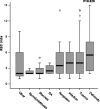Risk analysis of blood transfusion requirements in emergency and elective spinal surgery
- PMID: 20582708
- PMCID: PMC3082666
- DOI: 10.1007/s00586-010-1500-0
Risk analysis of blood transfusion requirements in emergency and elective spinal surgery
Abstract
Spinal surgery has long been considered to have an elevated risk of perioperative blood loss with significant associated blood transfusion requirements. However, a great variability exists in the blood loss and transfusion requirements of differing patients and differing procedures in the area of spinal surgery. We performed a retrospective study of all patients undergoing spinal surgery who required a transfusion≥1 U of red blood cells (RBC) at the National Spinal Injuries Unit (NSIU) at the Mater Misericordiae University Hospital over a 10-year period. The purpose of this study was to identify risk factors associated with significant perioperative transfusion allowing the early recognition of patients at greatest risk, and to improve existing transfusion practices allowing safer, more appropriate blood product allocation. 1,596 surgical procedures were performed at the NSIU over a 10-year period. 25.9% (414/1,596) of these cases required a blood transfusion (n=414). Surgical groups with a significant risk of requiring a transfusion>2 U RBC included deformity surgery (RR=3.351, 95% CI 1.123-10.006, p=0.03), tumor surgery (RR=3.298, 95% CI 1.078-10.089, p=0.036), and trauma surgery (RR=2.444, 95% CI 1.183-5.050, p=0.036). Multivariable logistic regression analysis identified multilevel surgery (>3 levels) as a significant risk of requiring a transfusion>2 U RBC (RR=4.682, 95% CI 2.654-8.261, p<0.0001). Several risk factors in the spinal surgery patient were identified as corresponding to significant transfusion requirements. A greater awareness of the risk factors associated with transfusion is required in order to optimize patient management.
Figures
Similar articles
-
Massive blood loss in elective spinal and orthopedic surgery: Retrospective review of intraoperative transfusion strategy.J Clin Anesth. 2017 Feb;37:69-73. doi: 10.1016/j.jclinane.2016.10.017. Epub 2017 Jan 3. J Clin Anesth. 2017. PMID: 28235532
-
Rates, Risk Factors, and Complications of Red Blood Cell Transfusion in Metastatic Spinal Tumor Surgery: An Analysis of a Prospective Multicenter Surgical Database.World Neurosurg. 2020 Jul;139:e308-e315. doi: 10.1016/j.wneu.2020.03.202. Epub 2020 Apr 13. World Neurosurg. 2020. PMID: 32298819
-
Postoperative Nonpathologic Fever After Spinal Surgery: Incidence and Risk Factor Analysis.World Neurosurg. 2017 Jul;103:78-83. doi: 10.1016/j.wneu.2017.03.119. Epub 2017 Apr 2. World Neurosurg. 2017. PMID: 28377245
-
Risk of infectious complications associated with blood transfusion in elective spinal surgery-a propensity score matched analysis.Spine J. 2016 Jan 1;16(1):55-60. doi: 10.1016/j.spinee.2015.10.014. Epub 2015 Oct 20. Spine J. 2016. PMID: 26499767
-
Perioperative Complications of Spinal Metastases Surgery.Clin Spine Surg. 2017 Feb;30(1):4-13. doi: 10.1097/BSD.0000000000000484. Clin Spine Surg. 2017. PMID: 27984252 Review.
Cited by
-
Incidence, Predictors, and Postoperative Complications of Blood Transfusion in Thoracic and Lumbar Fusion Surgery: An Analysis of 13,695 Patients from the American College of Surgeons National Surgical Quality Improvement Program Database.Global Spine J. 2016 Dec;6(8):756-764. doi: 10.1055/s-0036-1580736. Epub 2016 Mar 31. Global Spine J. 2016. PMID: 27853659 Free PMC article.
-
Corner Osteotomy As the More Advanced Approach to Deformity Correction in Adult Spinal Deformity: A Retrospective Comparative Study Between Two Osteotomy Techniques.Spine (Phila Pa 1976). 2025 Jun 15;50(12):E223-E230. doi: 10.1097/BRS.0000000000005124. Epub 2024 Aug 23. Spine (Phila Pa 1976). 2025. PMID: 39177114 Free PMC article.
-
Minimizing Blood Loss in Spine Surgery.Global Spine J. 2020 Jan;10(1 Suppl):71S-83S. doi: 10.1177/2192568219868475. Epub 2020 Jan 6. Global Spine J. 2020. PMID: 31934525 Free PMC article.
-
Comparison of parameter types for the calibration of noninvasive continuous cardiac output monitoring of patients undergoing lumbar spinal surgery in the prone position.Technol Health Care. 2023;31(6):2009-2019. doi: 10.3233/THC-220520. Technol Health Care. 2023. PMID: 37248925 Free PMC article.
-
Effect of oral tranexamic acid on postoperative bleeding in spinal surgery: a randomized controlled trial.Ann Med Surg (Lond). 2024 Jun 10;86(8):4483-4487. doi: 10.1097/MS9.0000000000001820. eCollection 2024 Aug. Ann Med Surg (Lond). 2024. PMID: 39118779 Free PMC article.
References
-
- Lemaire R (2008) Strategies for blood management in orthopaedic and trauma surgery. J Bone Joint Surg Br 90(9):1128–1136 - PubMed
MeSH terms
LinkOut - more resources
Full Text Sources
Medical


